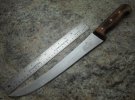- Joined
- Nov 28, 2014
- Messages
- 1,864
I'm going to make a breaking knife for breaking down shoulders and such and to cut steaks or slabs off a roast. My understanding is they are similar to a carving knife. My plan is to use 3/32 AEBL. So I'm thinking an 8" blade around 1" tall, slightly upswept blade with a little distal taper? I think it doesn't need too be flexible like a fillet knife but not stiff either. I will draw one up tonight and post it. Any tips or recommendations are appreciated. Thanks!


